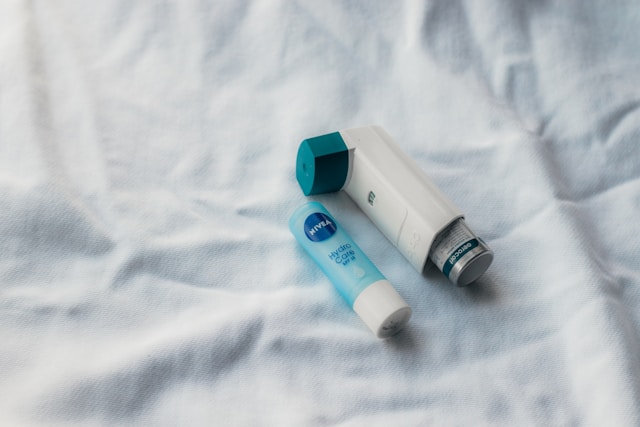
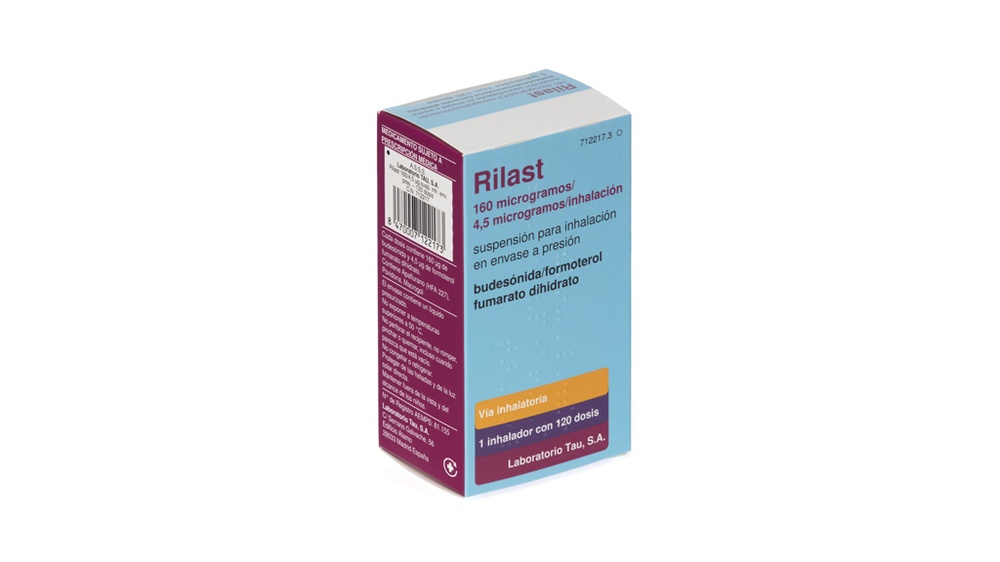
РИЛАСТ 160/4,5 мкг/ингаляция суспензия для ингаляций под давлением

Спросите врача о рецепте на РИЛАСТ 160/4,5 мкг/ингаляция суспензия для ингаляций под давлением

Инструкция по применению РИЛАСТ 160/4,5 мкг/ингаляция суспензия для ингаляций под давлением
Введение
Инструкция: информация для пользователя
Риласт 160 микрограмм/4,5 микрограмма/ингаляция суспензия для ингаляции в баллоне под давлением
Будесонид/формотерол фумарат дигидрат
Прочитайте внимательно всю инструкцию перед началом использования этого лекарства, поскольку она содержит важную информацию для вас.
- Сохраните эту инструкцию, поскольку вам может потребоваться прочитать ее снова.
- Если у вас есть какие-либо вопросы, проконсультируйтесь с вашим врачом или фармацевтом.
- Это лекарство было назначено только вам, и не передавайте его другим людям, даже если у них такие же симптомы, как у вас, поскольку оно может нанести им вред.
- Если вы испытываете побочные эффекты, проконсультируйтесь с вашим врачом или фармацевтом, даже если это побочные эффекты, которые не указаны в этой инструкции. См. раздел 4.
Содержание инструкции
- Что такое Риласт и для чего он используется
- Что вам нужно знать перед началом использования Риласта
- Как использовать Риласт
- Возможные побочные эффекты
- Хранение Риласта
- Содержание упаковки и дополнительная информация
1. Что такое Риласт и для чего он используется
Риласт - это ингалятор, используемый для симптоматического лечения хронической обструктивной болезни легких (ХОБЛ) у взрослых старше 18 лет. ХОБЛ - это хроническое заболевание дыхательных путей легких, часто вызываемое табачным дымом. Он содержит два разных лекарства: будесонид и формотерол фумарат дигидрат.
- Будесонид относится к группе лекарств, называемых "кортикостероидами", и действует путем уменьшения и предотвращения воспаления легких.
- Формотерол фумарат дигидрат относится к группе лекарств, называемых "бета2-адренергические агонисты длительного действия" или "бронходилататоры", и действует путем расслабления мышц дыхательных путей, что помогает вам дышать более легко.
Не используйте это лекарство как ингалятор "для облегчения".
2. Что вам нужно знать перед началом использования Риласта
Не используйте Риласт:
- если вы аллергичны к будесониду, формотеролу или любому другому компоненту этого лекарства (указанному в разделе 6).
Предостережения и меры предосторожности
Проконсультируйтесь с вашим врачом или фармацевтом перед началом использования Риласта, если:
- У вас есть диабет.
- У вас есть легочная инфекция.
- У вас есть высокое кровяное давление или вы когда-либо имели сердечное заболевание (включая нерегулярные сердечные сокращения, учащенное сердцебиение, сужение артерий или сердечную недостаточность).
- У вас есть проблемы с щитовидной железой или надпочечниками.
- У вас есть низкий уровень калия в крови.
- У вас есть тяжелые проблемы с печенью.
Свяжитесь с вашим врачом, если у вас出现ила размытость зрения или другие нарушения зрения.
Использование в спорте
Это лекарство содержит формотерол, который может давать положительный результат в тестах на допинг.
Дети и подростки
Риласт не рекомендуется для детей и подростков младше 18 лет.
Другие лекарства и Риласт
Сообщите вашему врачу или фармацевту, если вы используете, недавно использовали или можете использовать любое другое лекарство.
В частности, сообщите вашему врачу или фармацевту, если вы используете любое из следующих лекарств:
- Бета-блокаторы (например, атенолол и пропранолол для высокого кровяного давления), включая глазные капли (например, тимолол для глаукомы).
- Лекарства для лечения учащенного или нерегулярного сердцебиения (например, хинидин).
- Лекарства, такие как дигоксин, обычно используемые для лечения сердечной недостаточности.
- Мочегонные средства (например, фуросемид), используемые для лечения высокого кровяного давления.
- Оральные стероидные лекарства (например, преднизолон).
- Ксантины (например, теофиллин или аминофиллин), обычно используемые для лечения ХОБЛ или астмы.
- Другие бронходилататоры (например, салбутамол).
- Трициклические антидепрессанты (например, амитриптилин) и антидепрессант нефазодон.
- Фенотиазиновые лекарства (например, хлорпромазин и прохлорперазин).
- Лекарства, называемые "ингибиторами протеазы ВИЧ" (например, ритонавир) для лечения ВИЧ.
- Лекарства для лечения инфекций (например, кетоконазол, итраконазол, вориконазол, позаконазол, кларитромицин и телитромицин).
- Лекарства для лечения болезни Паркинсона (например, леводопа).
- Лекарства для лечения проблем с щитовидной железой (например, левотироксин).
Если вы находитесь в любой из этих ситуаций или если вы не уверены, спросите вашего врача или фармацевта перед использованием Риласта.
Сообщите также вашему врачу или фармацевту, если вы собираетесь пройти общую анестезию для хирургической операции или стоматологического лечения.
Беременность, лактация и фертильность
- Сообщите вашему врачу перед использованием этого лекарства, если вы беременны или планируете стать беременной; не используйте Риласт, если только ваш врач не назначит его.
- Если вы становитесь беременной во время лечения Риластом, не прекращайте его использование и проконсультируйтесь с вашим врачом немедленно.
- Если вы кормите грудью, проконсультируйтесь с вашим врачом перед использованием Риласта.
Вождение и использование машин
Влияние Риласта на способность управлять транспортными средствами и работать с механизмами является незначительным или отсутствует.
3. Как использовать Риласт
- Следуйте точно инструкциям по применению этого лекарства, указанным вашим врачом или фармацевтом. В случае сомнений проконсультируйтесь с вашим врачом или фармацевтом снова.
- Важно использовать Риласт ежедневно, даже если вы не испытываете симптомов ХОБЛ в данный момент.
Рекомендуемая доза составляет 2 ингаляции дважды в день. Не рекомендуется использовать Риласт для детей и подростков младше 18 лет.
Если вы принимали оральные стероидные таблетки для ХОБЛ, ваш врач может уменьшить количество таблеток, которые вы принимаете, после начала лечения Риластом. Если вы принимали оральные стероидные таблетки в течение длительного времени, ваш врач может захотеть сделать анализ крови время от времени. Когда количество оральных стероидных таблеток будет уменьшено, вы можете испытать общее недомогание, даже если ваши легочные симптомы улучшатся. В этом случае могут временно появиться некоторые симптомы, такие как заложенность носа или насморк, слабость или боль в мышцах или суставах и кожная сыпь (уртикария). Свяжитесь с вашим врачом, если любой из этих симптомов вас беспокоит или если у вас появляются другие симптомы, такие как головная боль, усталость, тошнота или рвота. Если появляются симптомы аллергии или артрита, вам может потребоваться принять другое лекарство. Вы должны проконсультироваться с вашим врачом, если вы обеспокоены тем, следует ли продолжать использовать Риласт.
Ваш врач может рассмотреть возможность добавления стероидных таблеток к вашему обычному лечению во время периодов стресса (например, когда у вас есть инфекция в груди или перед операцией).
Важная информация о симптомах ХОБЛ
Если во время использования Риласта вы испытываете затруднение дыхания или появляются "хрипы" при дыхании, продолжайте использовать его и свяжитесь с вашим врачом как можно скорее, поскольку вам может потребоваться дополнительное лечение.
Немедленно свяжитесь с вашим врачом, если:
- Ваше дыхание ухудшается или вы часто просыпаетесь ночью с симптомами нехватки воздуха.
- Вы начинаете испытывать чувство сдавления в груди утром или сдавление в груди продолжается дольше, чем обычно.
- Эти признаки могут указывать на то, что ваша ХОБЛ не контролируется хорошо и вам может потребоваться немедленно другое или дополнительное лечение.
Ваш врач может назначить вам другие бронходилататоры, например антихолинергические средства (например, тиотропий или бромур йодопратропия) для ХОБЛ.
Информация о вашем новом ингаляторе Риласт
- Перед использованием вашего нового ингалятора Риласта удалите его из алюминиевой упаковки. Выбросьте упаковку, а также высушивающий агент, находящийся внутри упаковки. Не используйте ингалятор, если высушивающий агент выпал из упаковки.
- Ингалятор должен использоваться в течение 3 месяцев после удаления из алюминиевой упаковки. Запишите на этикетке ингалятора дату окончания срока использования (3 месяца после удаления из упаковки), чтобы напомнить вам, когда следует прекратить использование ингалятора.
- На изображении показаны части, из которых состоит ингалятор, который уже будет собран, когда его вам дадут. Не разбирайте детали. Если контейнер ослабнет, верните его в ингалятор и продолжайте использовать.
Подготовка Риласта
Необходимо подготовить ингалятор к использованию в следующих ситуациях:
- Если вы используете ваш новый Риласт впервые.
- Если вы не использовали его в течение более 7 дней.
- Если он упал.
Чтобы подготовить ингалятор к использованию, следуйте следующим инструкциям:
- Встряхните ингалятор хорошо в течение как минимум 5 секунд, чтобы смешать содержимое аэрозольного картриджа.
- Удалите крышку мундштука, слегка нажав на выступы на боковой части. Крышка мундштука останется прикрепленной к ингалятору.
- Держите ингалятор в вертикальном положении. Затем нажмите на счетчик (в верхней части ингалятора), чтобы выпустить распыление в воздух. Вы можете использовать одну или обе руки, как показано на фотографиях.
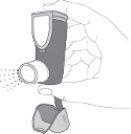
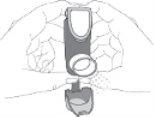
- Удалите палец (пальцы) со счетчика.
- Подождите 10 секунд, встряхните хорошо и повторите шаги 3 и 4.
- Ваш ингалятор теперь готов к использованию.
Как сделать ингаляцию
Каждый раз, когда вам нужно сделать ингаляцию, следуйте этим инструкциям:
- Встряхните ингалятор хорошо в течение как минимум 5 секунд, чтобы смешать содержимое аэрозольного картриджа.
- Удалите крышку мундштука, слегка нажав на выступы на боковой части. Проверьте, что мундштук не заблокирован.
- Держите ингалятор в вертикальном положении (вы можете использовать одну или обе руки). Медленно выдохните воздух.
- Аккуратно поместите мундштук между зубами. Закройте губы.
- Вдыхайте медленно и глубоко через рот. Твердо нажмите на счетчик (в верхней части ингалятора), чтобы выпустить распыление. Держите воздух в течение момента, нажимая на счетчик. Вдыхайте одновременно с нажатием на счетчик, чтобы обеспечить попадание лекарства в легкие.
- Держите дыхание в течение 10 секунд или максимально возможного времени.
- Перед выдохом, отпустите палец со счетчика и удалите ингалятор изо рта. Держите ингалятор в вертикальном положении.
 Выдохните воздух медленно. Перед повторной ингаляцией встряхните ингалятор хорошо в течение как минимум 5 секунд и повторите шаги с 3 по 7.
Выдохните воздух медленно. Перед повторной ингаляцией встряхните ингалятор хорошо в течение как минимум 5 секунд и повторите шаги с 3 по 7.- Закройте мундштук снова.
- Прополощите рот водой после утренней и вечерней доз.
Использование камеры-распределителя
Ваш врач, медсестра или фармацевт могут предложить вам использовать камеру-распределитель (например, Aerochamber Plus Flow Vuили Aerochamber Plus). Следуйте инструкциям, указанным в инструкции, прилагаемой к камере-распределителю.
Очистка Риласта
- Очистите внутреннюю и внешнюю часть мундштука как минимум один раз в неделю сухой тканью.
- Не используйте воду или жидкости и не разбирайте картридж ингалятора.
Как узнать, когда нужно заменить ваш ингалятор Риласт?
- Счетчик в верхней части ингалятора показывает, сколько ингаляций осталось в вашем ингаляторе Риласт. Он начинается с 120 ингаляций, когда полон.
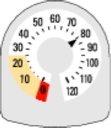
- Каждый раз, когда вы делаете ингаляцию или выпускаете распыление в воздух, стрелка начинает обратный отсчет до нуля ('0').
- Когда стрелка впервые входит в желтую зону, это означает, что осталось около 20 ингаляций.
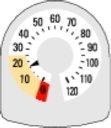
- Когда стрелка достигает '0', вы должны прекратить использование вашего нового ингалятора Риласт. Вам может не казаться, что ингалятор пуст, и он может казаться работающим, но на самом деле вы не получите правильное количество лекарства, если продолжите использовать его.
Если вы используете больше Риласта, чем должно быть
Если вы использовали больше Риласта, чем должно быть, свяжитесь с вашим врачом или фармацевтом. Симптомы и признаки, которые могут возникнуть после передозировки, являются наиболее часто встречающимися дрожанием, головной болью и учащенным сердцебиением.
В случае передозировки или случайного приема внутрь проконсультируйтесь с Центром токсикологической информации. Телефон: 91 5620420, указав лекарство и количество, принятое внутрь.
Если вы забыли использовать Риласт
- Если вы забыли какую-либо из двух доз Риласта, продолжайте лечение, рекомендованное как можно скорее. Однако, если это почти время вашей следующей дозы, не беспокойтесь о забытой дозе.
- Неиспользуйте двойную дозу, чтобы компенсировать забытые дозы.
Если вы прекратите лечение Риластом
Прежде чем прекратить использование Риласта, вы должны проконсультироваться с вашим врачом или фармацевтом. Если вы прекратите использование Риласта, симптомы и признаки ХОБЛ могут ухудшиться.
Если у вас есть какие-либо другие вопросы о использовании этого лекарства, проконсультируйтесь с вашим врачом или фармацевтом.
4. Возможные побочные эффекты
Как и все лекарства, это лекарство может вызывать побочные эффекты, хотя не все люди испытывают их.
Если вы испытываете любую из следующих ситуаций, прекратите использовать Риласт и немедленно проконсультируйтесь с вашим врачом:
- У вас появляется отек лица, особенно вокруг рта (языка и/или горла) или появляется крапивница вместе с затруднением дыхания (ангиоэдема) и/или вы чувствуете внезапное чувство слабости, что указывает на то, что вы можете испытывать аллергическую реакцию. Это происходит редко, затрагивая менее 1 из 1000 пациентов.
- У вас появляются "хрипы" или затруднение дыхания сразу после использования вашего ингалятора. Если у вас出现ят любые из этих симптомов, немедленно прекратите использовать Риласт и используйте ваш "ингалятор для облегчения". Свяжитесь с вашим врачом немедленно, поскольку вам может потребоваться изменение лечения.Это происходит очень редко, затрагивая менее 1 из 10 000 пациентов.
Другие возможные побочные эффекты:
Частые (могут затронуть до 1 из 10 пациентов)
- Сердцебиение (чувство сердечных сокращений), дрожание или озноб. Эти эффекты, если они появляются, обычно легкие и исчезают, когда вы продолжаете использовать Риласт.
- Мугет (грибковая инфекция) во рту; этот эффект менее вероятен, если вы прополощите рот водой после использования Риласта.
- Легкая раздражение горла, кашель, хрипота.
- Головная боль.
- Пневмония (инфекция легких) у пациентов с ХОБЛ.
Сообщите вашему врачу, если у вас есть любой из следующих симптомов во время ингаляции Риласта, они могут быть симптомами легочной инфекции:
- Лихорадка или озноб.
- Увеличение производства мокроты, изменение цвета мокроты.
- Увеличение кашля или затруднение дыхания.
Редкие (могут затронуть до 1 из 100 пациентов)
- Тревога, беспокойство, нервозность.
- Затруднение засыпания.
- Головокружение.
- Тошнота (неприятное ощущение).
- Учащенное сердцебиение.
- Синяки на коже.
- Мышечные спазмы.
- Размытость зрения.
Очень редкие (могут затронуть до 1 из 1000 пациентов)
- Сыпь, зуд.
- Бронхоспазм (сужение мышц дыхательных путей, вызывающее "хрипы"). Если у вас появляются "хрипы" сразу после использования Риласта, прекратите его использование и немедленно проконсультируйтесь с вашим врачом.
- Низкий уровень калия в крови.
- Нерегулярное сердцебиение.
Чрезвычайно редкие (могут затронуть до 1 из 10 000 пациентов)
- Депрессия.
- Изменения в поведении, особенно у детей.
- Боль или сдавление в груди (стенокардия).
- Увеличение количества сахара (глюкозы) в крови.
- Нарушения вкуса, такие как неприятный вкус во рту.
- Изменения артериального давления.
Ингаляционные кортикостероиды могут влиять на нормальное производство стероидных гормонов в организме, особенно если используются высокие дозы в течение длительного времени. Эти эффекты включают:
- изменения в плотности костей (истончение костей)
- катаракта (потеря прозрачности хрусталика в глазу)
- глаукома (увеличение давления в глазу)
- замедление роста у детей и подростков
- эффекты на надпочечные железы (маленькие железы, расположенные рядом с почками).
Эти эффекты намного менее вероятны с ингаляционными кортикостероидами, чем с оральными стероидными таблетками.
Сообщение о побочных эффектах
Если вы испытываете любой побочный эффект, проконсультируйтесь с вашим врачом или фармацевтом, даже если это возможные побочные эффекты, которые не указаны в этой инструкции. Вы также можете сообщить о них напрямую через Испанскую систему фармаковигиланса для лекарств для человека: www.notificaRAM.es. Сообщая о побочных эффектах, вы можете внести свой вклад в предоставление более полной информации о безопасности этого лекарства.
5. Хранение Риласта
- Храните это лекарство в недоступном для детей месте.
- Не используйте это лекарство после даты истечения срока годности, указанной на картонной упаковке, алюминиевом блистере или этикетке после CAD. Дата истечения срока годности - последний день указанного месяца.
- Как и в случае с большинством ингаляционных лекарств в аэрозольных упаковках, эффект этого лекарства может уменьшиться, когда баллон холодный. Для достижения лучших результатов это лекарство должно быть при комнатной температуре перед использованием. Не охлаждать и не замораживать. Защищать от мороза и прямого солнечного света.
- Лекарство должно быть использовано в течение 3 месяцев после того, как ингалятор был удален из алюминиевой упаковки. Запишите дату истечения срока годности (3 месяца после открытия упаковки) на этикетке ингалятора, чтобы напомнить себе, когда следует прекратить использование ингалятора.
- Всегда возвращайте крышку嘴ика в положение после использования ингалятора и закрепляйте ее.
- Лекарства не должны выбрасываться в канализацию или в мусор. Поместите упаковку и лекарства, которые вам больше не нужны, в пункт SIGRE аптеки. Спросите у вашего фармацевта, как избавиться от упаковки и лекарств, которые вам больше не нужны. Таким образом, вы поможете защитить окружающую среду.
Предупреждение: Баллон содержит сжатую жидкость. Не подвергайте воздействию температур выше 50°C. Не прокалывайте контейнер. Баллон не должен быть разрушен, проколот или сожжен, даже если он кажется пустым.
6. Содержимое упаковки и дополнительная информация
Состав Риласта
Активные вещества - будесонид и формотерол фумарат дигидрат. Каждая доза для ингаляции содержит 160 микрограммов будесонида и 4,5 микрограмма формотерола фумарата дигидрата.
Другие вспомогательные вещества - апафлуран (HFA 227), повидон и макрогол. Этот ингалятор не содержит ХФУ.
Это лекарство содержит фторированные газы, способствующие парниковому эффекту. Каждый ингалятор содержит 10,6 г апафлурана (HFC-227ea), соответствующих 0,034 тоннам CO2-эквивалента (потенциал глобального потепления ПГП = 3220).
Внешний вид продукта и содержимое упаковки
Риласт - это ингалятор, содержащий ваше лекарство. Баллон с указателем дозы, содержащий белую суспензию для ингаляции, прикреплен к пластиковому адаптеру красного цвета с белой пластиковой嘴кой и интегрированной серой пластиковой крышкой. Каждый ингалятор содержит 120 ингаляций после подготовки к использованию. Каждый ингалятор упакован индивидуально в бумажную алюминиевую упаковку, содержащую десикант.
Риласт 160 микрограмм/4,5 микрограмма/ингаляция суспензия для ингаляции в аэрозольной упаковке (будесонид/формотерол фумарат дигидрат) доступен в упаковках с одним ингалятором.
Владелец разрешения на маркетинг и ответственный за производство
Владелец:
Лаборатория TAU, S.A.
ул. Пуэрто де Сомпорт 21-23
28050 Мадрид
Испания
Ответственный за производство:
AstraZeneca Dunkerque Production
224, авеню де ла Дордонь БП 41
59640 Дюнкерк (Франция)
Это лекарство разрешено в государствах-членах Европейского экономического пространства под следующими названиями:
Страна | Торговое название и концентрация |
Испания | Риласт 160 мкг/4,5 мкг/ингаляция суспензия для ингаляции в аэрозольной упаковке |
Швеция | Гардете 160 микрограмм/4,5 микрограмма/ингаляция |
Дата последнего обзора этой инструкции: январь 2025 г.
Подробная информация о этом лекарстве доступна на сайте Испанского агентства по лекарствам и медицинским продуктам (AEMPS) http://www.aemps.gob.es/

Сколько стоит РИЛАСТ 160/4,5 мкг/ингаляция суспензия для ингаляций под давлением в Испании в 2025 году?
Средняя цена на РИЛАСТ 160/4,5 мкг/ингаляция суспензия для ингаляций под давлением в декабрь, 2025 года составляет около 39.56 евро. Финальная стоимость может зависеть от региона, конкретной аптеки и рецептурного статуса. Для точной информации лучше проверить онлайн или в ближайшей аптеке.
- Страна регистрации
- Средняя цена в аптеках39.56 EUR
- Активное вещество
- Требуется рецептДа
- Производитель
- Информация носит справочный характер и не является медицинской рекомендацией. Перед приемом любых препаратов проконсультируйтесь с врачом. Oladoctor не несет ответственности за медицинские решения, принятые на основе этого контента.
- Аналоги РИЛАСТ 160/4,5 мкг/ингаляция суспензия для ингаляций под давлениемФорма выпуска: ИНГАЛЯЦИЯ ЛЕГОЧНАЯ, 160 микрограмм / 4,5 микрограммаАктивное вещество: formoterol and budesonideПроизводитель: Teva Pharma B.V.Требуется рецептФорма выпуска: ИНГАЛЯЦИЯ ЛЕГОЧНАЯ, 320 микрограмм / 9 микрограммАктивное вещество: formoterol and budesonideПроизводитель: Teva Pharma B.V.Требуется рецептФорма выпуска: ИНГАЛЯЦИЯ ЛЕГОЧНАЯ, 160 МИКРОГРАММ/4,5 МИКРОГРАММААктивное вещество: formoterol and budesonideПроизводитель: Cipla Europe N.V.Требуется рецепт
Аналоги РИЛАСТ 160/4,5 мкг/ингаляция суспензия для ингаляций под давлением в других странах
Лучшие аналоги с тем же действующим веществом и терапевтическим эффектом.
Аналог РИЛАСТ 160/4,5 мкг/ингаляция суспензия для ингаляций под давлением в Польша
Аналог РИЛАСТ 160/4,5 мкг/ингаляция суспензия для ингаляций под давлением в Украина
Врачи онлайн по РИЛАСТ 160/4,5 мкг/ингаляция суспензия для ингаляций под давлением
Консультация по дозировке, побочным эффектам, взаимодействиям, противопоказаниям и продлению рецепта на РИЛАСТ 160/4,5 мкг/ингаляция суспензия для ингаляций под давлением – по решению врача и с учетом местных правил.





